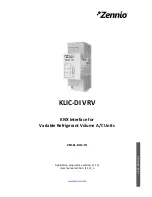
7
44 ซ.บรมราชชนนี 70 ถ.บรมราชชนนี ศาลาธรรมสพน์ ทวีวัฒนา กทม. 10170.
website:
Line ID: @add11 e-mail: [email protected]
Principle of Operation
Type CS400 Base Regulator Operation
Refer to Figure 2. When downstream demand
decreases, the pressure under the diaphragm
increases. This pressure overcomes the regulator
setting (which is set by the regulator control spring).
Through the action of the pusher post assembly, lever
and valve stem, the valve disk moves closer to the
orifice and reduces gas flow. If demand downstream
increases, pressure under the diaphragm decreases.
Spring force pushes the pusher post assembly
downward, the valve disk moves away from the
orifice and the gas flow increases downstream as the
regulator opens in response to the decreased pressure
underneath the diaphragm.
The Type CS400IR regulator includes an internal
relief valve for overpressure protection. If the
downstream pressure exceeds the regulator setting
by 7 to 28 in. w.c. / 17 to 69 mbar (depending on the
main spring used), the relief valve opens and excess
gas is vented through the stabilizer vent in the upper
spring case.
The Types CS400IT and CS400ET provide a low
capacity/token relief. Token relief provides relief
from minor overpressure caused by nicks or dents
on the orifice or by thermal expansion of gas in the
downstream line. Token relief also provides a token
or signal, in the form of odor, that an overpressure
situation is occurring.
Type CS403 Integral Monitor Operation
Type CS403 combines the operation of a conventional
two-regulator wide-open monitor set into one body, see
Figure 3. The Integral True-Monitor
TM
is installed on the
inlet side of the body and serves to throttle flow and
maintain an acceptable downstream pressure in the case
where the Primary regulator fails to regulate downstream
pressure. During normal operation the Integral Monitor is
in a wide-open state as its setpoint is set higher than the
primary regulator. See Table 6 for guidance regarding the
setpoints of the regulator and associated integral monitor
sets. If the downstream pressure should rise to the
setpoint of the internal monitor due to loss of pressure
control by the primary regulator, the integral monitor will
assume control and regulate the flow to the downstream
system. See the Type TM600 Instruction Manual for
additional details of operation.
If token relief is present, it will relieve a small amount of
gas to the atmosphere as an indication that the Integral
monitor is controlling the downstream pressure.
Type CS404 Slam-shut Operation
The Type VSX4 slam-shut module on the Type CS404
regulator is a fast acting shut-off device that provides
overpressure (OPSO) or over and underpressure
(OPSO / UPSO) protection by completely shutting
off the flow of gas to the downstream system. See
Tables 7 and 8 for guidance regarding the typical
setpoints of the regulator and associated OPSO
and UPSO setpoints. The Type VSX4’s actions
are independent of the Type CS404 regulator and
of variations to the inlet pressure. The Type VSX4
provides the option of internal or external downstream
pressure registration. External registration requires a
downstream sensing line. See Figure 7 for guidance
regarding installation of the downstream control line.
The Type VSX4 shut-off disk is normally in the open
(reset) position, see
Figure 4
. If the downstream
pressure below the slam-shut diaphragm increases (or
decreases) until it reaches the slam-shut setpoint, this
diaphragm moves upward (or downward) to release
the trip mechanism which allows the spring force on
the stem to push the disk against the seat, shutting off
all gas flow. To reset the slam shut after gas has been
shutoff, refer to Type VSX4 Instruction Manual for
additional details.
In order for the Underpressure Shutoff (UPSO) of
any slam-shut to be triggered, the downstream pipe
pressure must drop below the UPSO setpoint.
In the case of a downstream line break, numerous
factors can prevent the downstream pipe pressure from
decreasing below the slam-shut UPSO setpoint. These
factors include the distance of pipe to the break, the
diameter of the pipe, size of the break and the number
of restrictions, such as valves, elbows and bends,
downstream of the regulator and/or slam-shut device.
Due to these factors additional protections should be
installed to stop flow in the event of a line break.






































